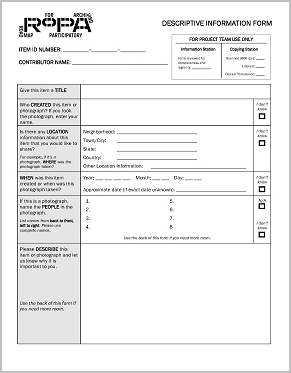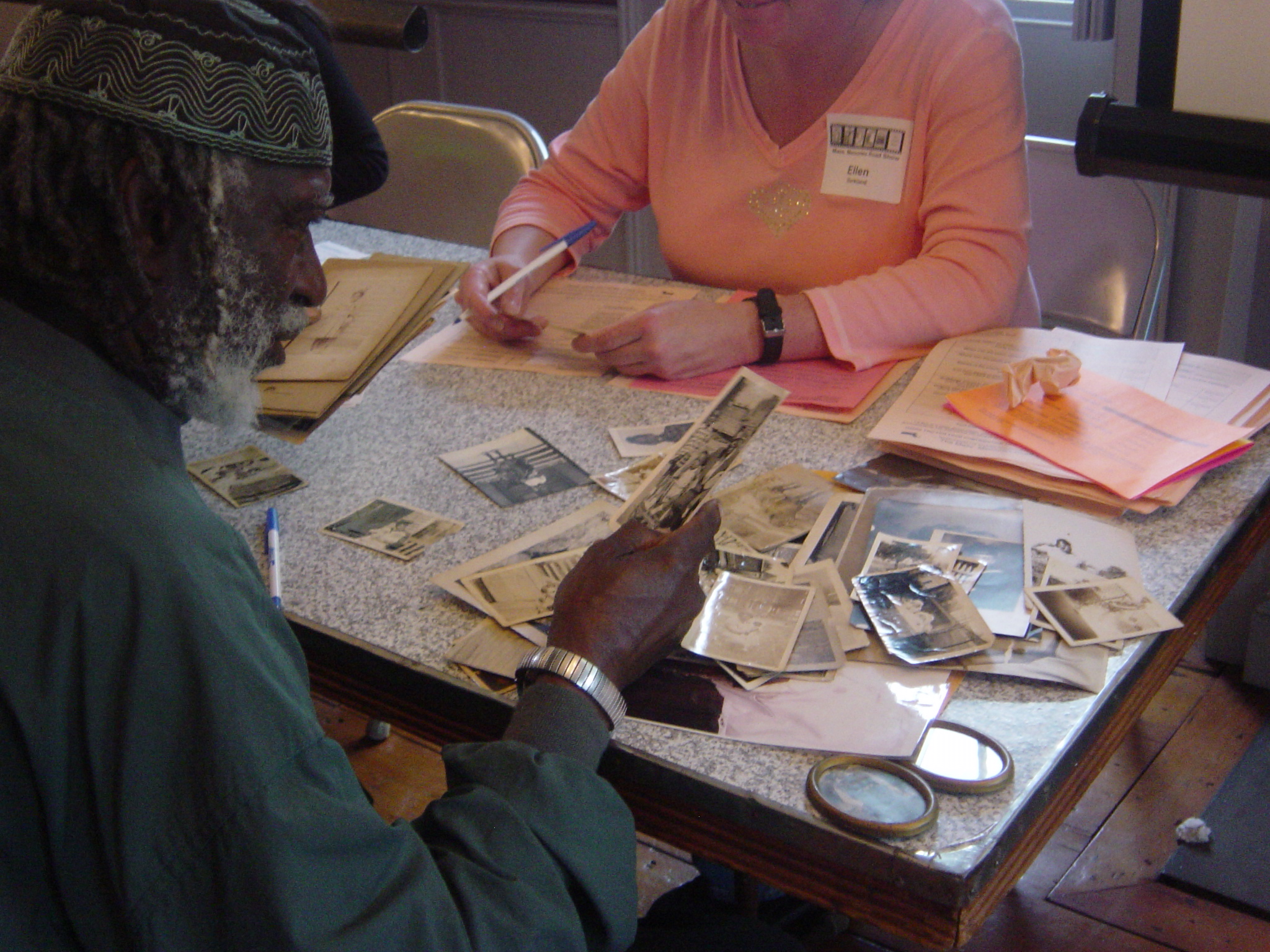Steps to Success: Before the Event
STEP 1
Designate the Information Station Captain.
The Collection Coordinator will designate a member of the Project Team to serve as the Information Station Captain. The Information Station Captain will oversee all activities related to the Information Station: from pre-event preparation and volunteer training, to day-of-event activities, including making sure that there is a fully completed Description Information Form per Item.
STEP 2
Determine whose voice will write the descriptive information.
One of the things that makes a participatory archiving collection unique is the choice the collecting organization has around the voice of the descriptive information and how that description will appear in the collection. In more traditional archives, an archivist researches and describes an item in the third person. At a participatory archiving event, there is an opportunity to allow a Contributor to describe an Item in their own words and to use that narrative as a part of the record.
While the question of what Items event Contributors should be encouraged to bring is more specifically addressed in the Collecting Stories module of RoPA, as a team you will also need to decide who will write the descriptive information. Will it be the collecting organization? The Contributor? Or a mix of both? Each choice presents advantages and challenges.
By allowing the collecting organization to write item descriptions, the collecting organization would be able to research the item and present historically accurate information. The Descriptive Information Form can be used as a starting point for research on the text that will be displayed with the collection. However, this can be time consuming and demands a level of expertise that many organizations do not have in-house. In addition, a unique and important human element is lost because the emotion and personal connection of a Contributor is removed.
By allowing the Contributor to write the Item description, you are empowering them to add their own voice to the historic record. Contributor-provided descriptions displayed in the collection can enrich the meaning behind Items and explain their importance to the community that may not be obvious to someone outside the community. However, a Contributor’s description may not always be historically or factually accurate.
There is no right or wrong choice here. How your Project Team moves forward should stem from the community and collection goals that you established at the beginning of the planning process. Check out the Best Practice Examples section of this module to explore how different organizations have made different choices about voice.
STEP 3
Adapt the Descriptive Information Form for your project.

Image of the Descriptive Information Form
At the Information Station, Contributors will complete a Descriptive Information Form (download as MS Word or PDF document) for each Item they are adding to the collection. It’s essential to capture descriptive information in a consistent way, using a well-developed model and form. After your event, the Collections Working Group will use the Descriptive Information Forms to put the collection online.
Descriptive Information Form
Descriptive information is what brings digital archival collections to life. This information provides context for the Item being collected, connects the Item to a Contributor’s personal experience in the community, and provides researchers with evidence of the Item’s cultural and historical significance.
It's important to consider your event, collection, and inclusiveness goals when thinking about collecting descriptive information.
- Do you need to add a section to the Descriptive Information Form to capture additional information?
- Do you need to change sections to match the decisions your Project Team made about voice?
- Are there topics that Contributors may be reluctant to share information about or that are considered taboo in a given community?
- Will your event offer forms in multiple languages to meet the unique needs of your community?
- If so, will the descriptions provided as part of an online collection remain in their original language? Or will you also provide translations of those transcriptions?
The Collection Coordinator will work with the Information Station Captain and the Community Coordinator to adapt the Descriptive Information Form for your event to collect the specific information that meets your project goals. There is a minimum amount of basic information that the RoPA Developers recommend collecting about each Item, keeping in mind that the information you collect will directly affect your digital repository and access to the collection. When the adapted form is complete, the Collection Coordinator will send the final version to the Event Coordinator to make copies to use at the event.
Handout: Understanding the Descriptive Information Form
The Collection Coordinator will also review the Understanding the Descriptive Information Form Handout (download as MS Word or PDF document) to make sure it matches the decisions the Project Team made. They will send a copy of the final handout to the Information Station Captain to distribute to volunteers and use for volunteer training. They will also send a final version of the handout to the Event Coordinator to make a few copies available at the Information Station the day of the event.
This tutorial video (below) describes the Descriptive Information Form in detail, highlights how this form employs the RoPA Numbering System, and explains how this form is connected to the Event Registration and Permission Form.
STEP 4
Determine how you will collect descriptive information from Contributors.
You've determined what information you plan to collect and updated the Descriptive Information Form, now how will you go about gathering this information on the day of the event?
The most efficient way to collect descriptive information is to have the individual Contributor write directly in the Descriptive Information Form, rather than have them dictate to a volunteer. The Information Station Volunteer’s role is to guide the Contributor through the form and answer any questions that arise. The dynamic between the Contributor and the volunteer is important because participatory archiving is a collaborative endeavor and requires shared authority.
There are a number of factors to consider here. You will want to be mindful of the Contributor’s needs and abilities and remain sensitive to any visual or physical impairments or language and reading abilities that may hinder their ability to write. You will want to encourage the Contributor to write the descriptive information themselves but be prepared to assist them when appropriate or if asked. In your planning for collecting descriptive information from Contributors, you should also be sure to address (in collaboration with the full Project Team) whether you feel it necessary to provide translators as part of the event.
The process of collecting descriptive information about Contributors’ Items will take place at the event’s Information Station, which is further described in the At the Event section of this module.
STEP 5
Determine whether you will limit the number of Items that people are allowed to contribute at your event.

A Volunteer helps Contributor decide which Items to contribute at the Dorchester Mass. Memories Road Show, 2006
The Community Coordinator, Event Coordinator, and Collection Coordinator together will determine whether there will be a limit to the number of Items that Contributors are allowed to contribute at your event.
This decision will stem from the reality that all participatory archiving events need to strike a balance among the priorities of the community, event, and the collection.
Your Project Team may be eager to collect everything it can and not restrict the Contributors to a certain number of Items; however, for your event to run smoothly and efficiently, this will likely not be possible. What if a Contributor brings a shoebox full of photographs or scrapbooks to your event? Will you have the time and resources to digitize these items at your event, and will the Contributor be able to provide the necessary descriptive information about each Item? Remember, each Contributor must complete one Descriptive Information Form for each Item they plan to contribute, which can be time-consuming. Describing Items takes focus and energy, and many Contributors may only be able to describe a limited number.
Limiting the number of Items allowed can serve two important goals: first, to ensure that the event can accommodate as many Contributors as possible, and second to set expectations about how many Items your Project Team will be able to process on the day of the event.
The question of what Items event Contributors should be encouraged to bring is more specifically addressed in the Collecting Stories module of RoPA.
If you do set a limit, Information Station Volunteers will work with Contributors to select which Items to include in the collection. Of course there is room to be flexible and to possibly permit people to contribute more Items if time allows.
STEP 6
Train the Information Station Volunteers at the Event Orientation and Training Session.
The Event Orientation and Training Session is an opportunity for the entire Project Team to come together before the event and learn about the details of what will happen on the event day. During the Event Orientation, volunteers will learn about the different stations, the numbering system, and all the forms Contributors will complete. After a short break, the Project Team will divide into groups for station-specific training.
At the Information Station Training Session, the Information Station Captain will:
- Train Volunteers on the Information Station role;
- Make sure Volunteers understand their role as supportive collaborators in facilitating Contributors’ stories;
- Review the Descriptive Information Form in detail with Volunteers (download as MS Word or PDF document), provide them with a copy of the Understanding the Descriptive Information Form Handout (download as MS Word or PDF document), and practice completing a form;
- Help volunteers understand the importance of the Information Station and the Descriptive Information Form to the Numbering System; and
- Teach volunteers how to review the Descriptive Information Form for completion and legibility.
STEP 7
Send a follow-up email to Information Station Volunteers.
After the Event Orientation and Training Session, the Information Station Captain will share the following informational documents and videos with all Information Station Volunteers and ask them to carefully review the materials again before the day of the participatory archiving event:
- RoPA Numbering System Overview (download as MS Word or PDF document);
- Understanding the Descriptive Information Form Handout (download as MS Word or PDF document);
- A link to the Understanding the Descriptive Information Form video.